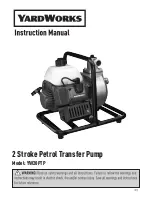
801-B00 Page 4/24
GENERAL INSTALLATION AND OPERATION
INTERNAL PUMP RELIEF VALVE AND
EXTERNAL BYPASS VALVE
NOTICE:
The pump internal relief valve is designed to protect the
pump from excessive pressure and must not be used as
a system pressure control valve.
For ALL liquefied gas applications, install an external bypass
valve, and any necessary piping, back to the tank. DO NOT
pipe the bypass valve back to the intake line. The setting on
the external bypass valve must be at least 25 psi (1.7 bar)
lower than the pump internal relief valve setting. Typically,
pump relief valves are factory set at the spring range mid-
point.
The valve and piping must be of adequate size to
accommodate the full flow from the pump when the discharge
line is closed.
The 'Alternate Discharge to Storage Tank' line and manual
valve may be used to unload transports without pumps into
the storage tank. The manual valve in this line must remain
closed during all other operations.
Refer to Blackmer Bypass Valve Installation and Maintenance
Instructions for bypass valve settings and adjustments.
Figure 3 – Bypass Valve Mounting
RELIEF VALVE SETTING AND ADJUSTMENT
The relief valve pressure setting is marked on a metal tag
attached to the valve cover. Generally, the relief valve should
be set at least 15 - 20 psi (1.0 - 1.4 Bar) higher than the
operating pressure, or the external bypass valve setting.
DO NOT remove the R /V Cap OR adjust the relief valve
pressure setting while the pump is in operation.
1.
To INCREASE the pressure setting,
remove the relief
valve cap, loosen the locknut, and turn the adjusting
screw
inwar
d, or clockwise. Replace the valve cap and O-
ring.
2.
To DECREASE the pressure settin
g, remove the relief
valve cap, loosen the locknut, and turn the adjusting
screw
outwar
d, or counterclockwise. Replace the valve
cap and O-ring.
Refer to the individual Blackmer pump parts lists for various
spring pressure ranges.
Incorrect settings of the pressure relief
valve can cause pump component
failure, personal injury, and property
damage.
Hazardous pressure
can cause personal
injury or property
damage
Relief valve cap is exposed to pumpage
and will contain some fluid
Hazardous or toxic
fluids can cause
serious injury.
CHECK VALVES
The use of check valves or foot valves in the supply tank is
not recommended with self-priming, positive displacement
pumps.
If the possibility of liquid backflow exists when the pump is off,
a check valve in the pump discharge piping is recommended
because the pump can motor in the reverse rotation and
create undue stress on all attached components. Never start
a pump when it is rotating in the reverse rotation as the added
starting torque can damage the pump and related equipment.
PUMP ROTATION
NOTICE:
Confirm correct pump rotation by checking the pump
rotation arrows respective to pump driver rotation.
Blackmer SGL pumps have a double ended rotor and shaft,
enabling them to be driven from either shaft end. To change
rotation, rotate the pump 180 degrees so that the opposite
shaft becomes the driven shaft. The shaft protector (186)
MUST be mounted over the non-driven shaft.
Operation without guards in place can
cause serious personal injury, major
property damage, or death.
Do not operate
without guard
in place





































